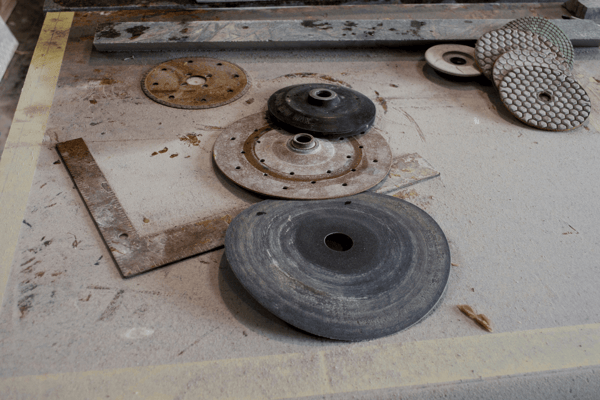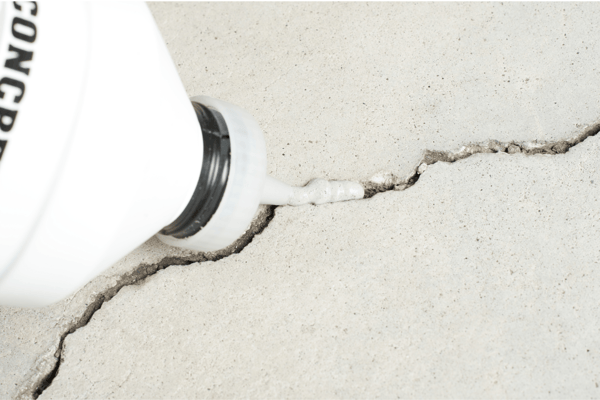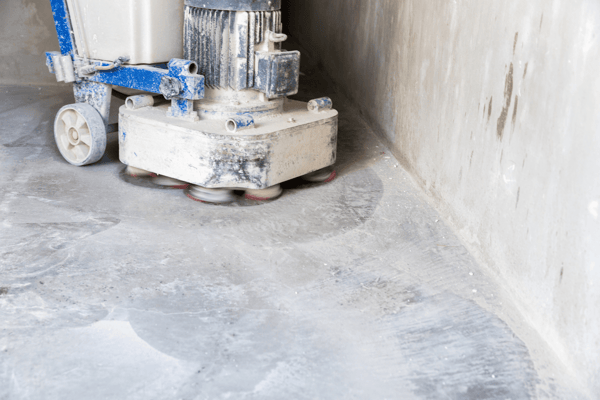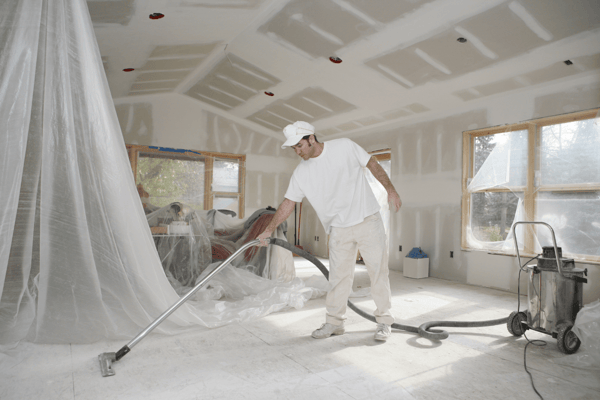Early concrete used by the Romans was made by mixing lime, volcanic ash, and water.
Thankfully concrete today has been upgraded, and is used in almost every facet of life—there's almost nothing that doesn't involve this versatile product.
You're probably most familiar with this excellent building component from your concrete garage floor. Over time, concrete garages endure significant abuse, from debris accumulation to all manner of spills, chips, and cracks.
Concrete garage floors can also be upgraded to an epoxy surface or painted, to create a clean, and easy-to-maintain surface. You may also need to grind your concrete floors to create an even and level surface for building purposes.
No matter why you're grinding your concrete floors, in this guide, we'll walk you through:
- The correct way to grind your concrete floors
- What tools you need
- And some different upgrade options

Tools for Concrete Floor Grinding
Depending on your project, there are a number of concrete grinders available, ranging in size and price. There are also a few other tools you'll need to complete the job.
Types of Concrete Grinders
There are generally two types of grinders used in residential projects: hand-held grinders and walk-behind grinders.
Hand-held grinders are good for corners, and small blemishes and upkeep, and are powered by a regular wall outlet.
Walk-behind grinders are best for large floors, like garages. These are powered by gas or propane and need to be operated outside or in very well-ventilated areas.
There are a couple of different options when choosing a concrete grinder, depending on your project.
Planetary grinders are great for large projects and have different grits much like sanding down wood.
Edge grinders are great for small spaces, corners, and—you guessed it—edges. This tool is great for big projects that you wouldn't otherwise want to use a hand grinder to finish edges and corners.
Tools for Cleaning
You'll want to clean up any residual dust from grinding concrete. You can simply use a wet/dry shop vacuum. However, there are specialty dust vacuums that work great on dusty concrete projects to protect the area and your lungs from harmful silica dust.

Grinding Concrete Floors
Concrete floors see a lot of abuse over the years. Thankfully, grinding away blemishes can restore your floors to smooth, blemish-free glory. Here we'll go over exactly how to grind concrete floors.
There are two ways you can grind your concrete floors: wet or dry. There are pros and cons to each option.
- Wet grinding: a wet floor grinder uses water to lubricate the concrete surface, and creates a slurry that will have to be cleaned after, which can be messy and difficult to clean up
- Dry grinding: a dry grinder does not use water. Some dry grinders have a dust collector to quickly suck up the dust that's created with dry grinding. Dry grinding creates a better polish on the floor, but it can put silica dust into the air, which can be harmful to inhale
You'll need to correctly prep the garage before you begin grinding the concrete.

Prepare the Garage
To start, repair cracks and pits in the concrete. Next, remove grease stains or oil spots.
Once that's complete, consider the items in your garage, perhaps on storage shelves, or on workbenches. If you're dry grinding, it's likely dust will get on all the items in your garage that aren't covered.
You can either remove, cover workbenches with plastic coverings, or blast the work area with an air blower after the work is complete—just be prepared for concrete dust to get on anything that isn't covered and plan accordingly.

Begin Grinding
If you're wet grinding your concrete floors, start by wetting the floor in sections (to avoid the areas drying before you can get to them, and having to do double the work).
Work your machine in small sections, and then test the surface of the area by feeling the texture of the surface.
Spray the area clean with a pressure hose before testing. If it feels like medium grit sandpaper, you're on the right track.
Work in sections across the floor, making sure to clean the areas you've worked on by sucking up the resulting slurry with a wet vacuum, and then pressure spraying the sections. It's important to not let the wet slurry dry, as it's difficult to clean and can impact the surface coating of the concrete.
With dry grinding, always wear a mask that's approved for concrete dust, as silica can be harmful when inhaled.
When grinding, make sure not to lean on or put extra pressure on the grinding machine, as this can create divots. The grinder is weighted to create a smooth and even surface, without extra weight added by you.
Finally, there will be a perimeter around the garage and in corners that push grinders can reach. For these areas, you'll need to use a hand grinder or an edger for larger projects.

Cleaning the Floor
After you've ground the floor, you'll want to clean away any remaining concrete dust.
A good way to check if there's remaining dust is to do a touch test, by running your fingers across the floor and seeing if there's a lot of residual white powder. Alternatively, you could get a piece of duct tape and stick it to the surface, and then check to see how much dust is picked up.
If there's a lot of residue left over, there's a couple of ways you can clean up.
If you wet ground the concrete, mix up TSP solution in a bucket, and then, using a long-handled brush, lightly scrub the floor.
Rinse the solution off using a high-pressure hose, and then squeegee the slurry into a central location and vacuum using a wet/dry shop vacuum.
If you did a dry grind, simply attach a wide-mouth vacuum attachment to your shop vacuum and thoroughly clean the area.
Now that you know how to grind a concrete garage floor, here are some great options to upgrade your concrete floor with finishes.

Upgrade the Garage Floor Surface
If you've gone to all the trouble of grinding concrete, why not upgrade the garage floor while you're at it?
We recommend concrete floor epoxy.
Epoxy is a long-lasting, beautiful option that's durable, tough, and perfect for garages. It can handle the abuse of cars moving in and out, grease and oil spills, and heavy equipment dropped on the surface without cracking.
Not only that, applying epoxy is relatively easy for the great benefit of a durable, beautiful surface. Plus, there are a number of great epoxy floor paints on the market, that come in a range of colors, finishes, and more.
You can get creative with floor epoxy to match just about any style or aesthetic.
Where to Get Your Concrete Grinder
Now that you know how to correctly grind your concrete garage floor project, it's time to buy the tools to get the job done.
If you're in the market for a concrete grinder, On Floor Technologies has a number of grinders, edgers, and vacuums, with many options to accommodate your project.
We also supply replacement parts and accessories—On Floor Technologies is your one-stop-shop for everything you need for your next concrete project.
To get started, request a demo.

0 comments